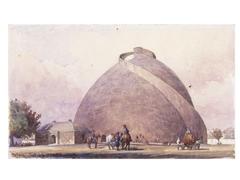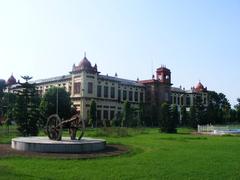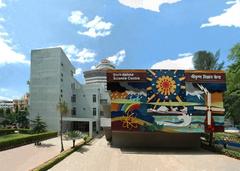Visiting Padri Ki Haveli: History, Tickets, and Tips
Date: 24/07/2024
Introduction
Embark on a journey through history as we explore Padri Ki Haveli, the oldest church in Bihar, India. Also known as the Visitation of the Blessed Virgin Mary, this architectural marvel in Patna stands as a testament to the resilience and cultural significance of religious structures in India. Established by Roman Catholics in 1713, the church was later redesigned in 1772 by Venetian architect Tirreto, who traveled from Kolkata specifically for this purpose (Incredible India). Over the centuries, Padri Ki Haveli has faced numerous adversities, including destruction by Nawab Mir Qasim in 1763 and damage during the Great Indian Rebellion of 1857. Despite these challenges, the church has been meticulously restored and preserved, maintaining its structural excellence and intricate architectural details (Wikipedia, Explore Our India). One of the most fascinating aspects of Padri Ki Haveli’s history is its connection to Mother Teresa, who received her formal training as a nurse at this church in 1948 (Incredible India). This comprehensive guide covers everything you need to know about visiting Padri Ki Haveli, from its rich historical background to practical visitor information, making it a must-visit landmark in Patna.
Historical Background
Early Establishment and Architectural Design
Padri Ki Haveli, also known as the Visitation of the Blessed Virgin Mary, holds the distinction of being the oldest church in Bihar. The Roman Catholics established the original structure in 1713 when they arrived in Bihar. This initial church was a modest construction, but it laid the foundation for what would become a significant religious and historical landmark in Patna. The church was later redesigned in 1772 by a Venetian architect named Tirreto, who traveled from Kolkata specifically for this purpose. The redesigned church boasts a foundation stone measuring 70 feet in length, 40 feet in width, and 50 feet in height (Incredible India).
Destruction and Reconstruction
The church has faced numerous adversities throughout its history. One of the most significant events occurred on June 25, 1763, when Nawab Mir Qasim, the ruler of Bengal, destroyed the church. This act of destruction was a consequence of a quarrel between Nawab Mir Qasim and British traders. The church’s ancient records were destroyed and burnt during this attack (Wikipedia).
The church faced further damage during the Great Indian Rebellion of 1857. Despite these challenges, the church was rebuilt and restored to its former glory. Today, it stands as an architectural wonder, showcasing intricate details that are rare in Indian churches (Explore Our India).
Mother Teresa’s Connection
One of the most fascinating aspects of Padri Ki Haveli’s history is its connection to Mother Teresa. In 1948, Mother Teresa received her formal training as a nurse at this church. The room where she stayed has been preserved and contains several of her belongings, including a cot and a table. A notice board in the room proclaims: “Mother Teresa, who started her mission of love after undertaking training at Padri Ki Haveli, stayed in this room, in 1948” (Incredible India).
Architectural Significance
The architectural design of Padri Ki Haveli is a testament to its historical and cultural significance. The church bell, which can be seen from a distance, is an awe-inspiring part of the structure. The bell is considered an architectural marvel and features intricate detailing and inscriptions. The church’s design has withstood numerous cataclysms over the years, including attacks and natural disasters, yet it continues to maintain its structural excellence (Hello Travel).
Cultural and Religious Importance
Padri Ki Haveli is not just a historical monument but also a significant religious site. People from all faiths regularly visit the church for prayer. During Christmas, the church takes on a festive look and sees a stream of devotees coming in to offer prayers. This inclusive atmosphere makes Padri Ki Haveli a unique place of worship in India (Explore Our India).
Visitor Information
Visiting Hours
Padri Ki Haveli remains open 24 hours, allowing visitors to explore its rich history and architectural beauty at any time (Thrillophilia).
Ticket Information
There is no entry fee to visit Padri Ki Haveli. However, donations are welcomed to aid in the maintenance and preservation of the church.
Travel Tips
- Best Time to Visit: The best time to visit Padri Ki Haveli is during the cooler months of October to March.
- What to Bring: Comfortable walking shoes, a camera for capturing the stunning architecture, and a water bottle.
- Special Events: Visiting during Christmas can offer a unique and festive experience.
Nearby Attractions
While visiting Padri Ki Haveli, consider exploring other historical sites in Patna such as:
- Golghar
- Patna Sahib Gurudwara
- Bihar Museum
- Mahavir Mandir
Accessibility
Padri Ki Haveli is accessible to people with disabilities. The church has ramps and other facilities to ensure a comfortable visit for all.
Preservation and Modern-Day Relevance
Despite the numerous challenges it has faced, Padri Ki Haveli continues to be a well-preserved monument. The church’s historical records, which were once destroyed, have been partially restored through various efforts. The church remains open 24 hours, allowing visitors to explore its rich history and architectural beauty at any time (Thrillophilia).
Visitor Experience
Visitors to Padri Ki Haveli can expect a rich historical and cultural experience. The church’s intricate architectural details, historical significance, and connection to Mother Teresa make it a must-visit site in Patna. The church bell, with its detailed inscriptions, is a highlight for many visitors. Additionally, the room where Mother Teresa stayed offers a glimpse into her early years and her mission of love (Navrang India).
FAQ
Q: What are the visiting hours for Padri Ki Haveli? A: The church is open 24 hours a day, allowing visitors to explore at any time.
Q: Is there an entry fee for Padri Ki Haveli? A: No, there is no entry fee. However, donations are welcomed.
Q: What is the best time to visit Padri Ki Haveli? A: The best time to visit is during the cooler months, from October to March.
Q: Are there any special events held at the church? A: Yes, visiting during Christmas offers a unique and festive experience.
Q: Is Padri Ki Haveli accessible for people with disabilities? A: Yes, the church has ramps and other facilities to ensure accessibility for all.
Conclusion
Padri Ki Haveli stands as a testament to the resilience and enduring significance of historical monuments. Its rich history, architectural beauty, and cultural importance make it a unique landmark in Patna. Whether you are a history enthusiast, an architecture lover, or a spiritual seeker, Padri Ki Haveli offers a memorable experience that transcends time and faith. Visiting this architectural marvel provides an opportunity to explore the rich cultural heritage of Patna and appreciate the intricate details that make this church a unique landmark. Plan your visit today to experience the historical and cultural richness of Padri Ki Haveli, and don’t forget to explore nearby attractions to make the most of your trip (Thrillophilia, Indian Culture).
References
- Incredible India, 2023 Incredible India
- Wikipedia, 2023 Wikipedia
- Explore Our India, 2023 Explore Our India
- Hello Travel, 2023 Hello Travel
- Navrang India, 2019 Navrang India
- Thrillophilia, 2023 Thrillophilia
- Indian Culture, 2023 Indian Culture




